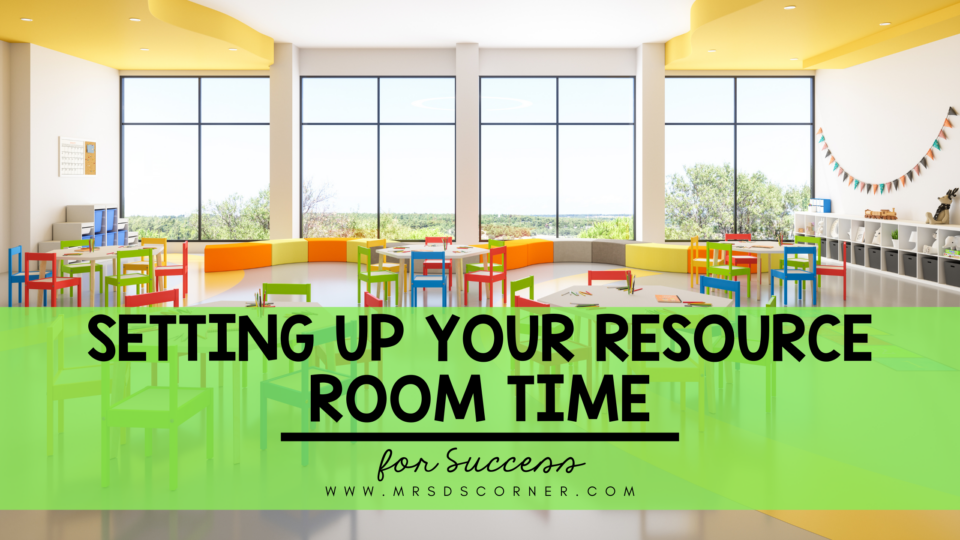As special ed teachers, we know the importance of every minute we spend with our students. Our goal is to create a supportive and enriching learning environment where every student’s needs are met and academic growth is fostered. But how can we organize our resource room time to make sure are students are successful and getting the support they need?


Here are some practical strategies and tips that can help you optimize your classroom time effectively. While the tips below are a great guide, keep in mind that going with the flow of unexpected interruptions and being pulled out for meetings can help alleviate some of the stress of having to “do it all” during your resource room time. We should always expect the unexpected!
Understanding Student Needs
First and foremost, it’s crucial to identify and understand the diverse needs of your students in the resource room. Each student has unique learning styles and requirements, not to mention IEP goals!
By recognizing these individual needs, you can tailor your teaching approach to better support their academic journey. The first step, though, is to make sure you read the IEPs and know what your students need. Don’t skip that step!
Creating a Structured Schedule
Organizing a structured schedule for your resource room time is key to maximizing productivity. Allocate specific time slots for different activities such as one-on-one support, independent work, and group collaboration. This will help create a routine that students can rely on and make the most out of their learning experience.
When there was a structured routine, my students were less anxious about what they should be doing or even about coming to the resource room in general. Knowing what to expect is important for you as the teacher, but it’s even more important for your students.
Maximizing Productivity
To enhance productivity during resource room time, consider creating a learning environment that’s designed to be productive. What does that entail? Organization, of course!
Ensure that the classroom setup is organized, free from distractions, and equipped with necessary resources. Encourage students to stay focused and engaged by implementing interactive teaching methods and providing clear instructions. Also, make sure that everything has a place so that students know where to find things and where to put them back when they’re done with them.
Addressing Individual Needs
Every student has unique strengths and challenges. Implementing differentiated instruction techniques during resource room time is essential for addressing individual needs. Offer personalized learning plans, provide additional support where needed, and adapt your teaching strategies to meet each student’s requirements.
Creating academic centers to use in the resource room is a great way to address all of those individual needs. This article shares some of my favorite tips and tricks for setting them up and planning!
It’s a tall order, for sure, but the resource room should be a safe place for students where they know they’re going to get the help they need in a way that they learn best.
Encouraging Collaboration
Fostering collaboration among students can greatly benefit their learning experience in the resource room. Encourage teamwork, peer support, and group activities to promote a sense of community and shared learning.
Oftentimes, students who drop into the resource room throughout the day are from different classes and, possibly from different grades. Building that sense of community is so important to help them feel comfortable and confident. By working together, students can exchange ideas, help each other, and build valuable social skills.
Utilizing Resources Effectively
Make the most out of available resources in the resource room setting. Incorporate technology, educational tools, and other materials to enhance learning opportunities for your students. Utilize interactive whiteboards, educational apps, and online resources to engage students and make learning more interactive and enjoyable.
Monitoring Progress and Adjusting Plans
Regularly monitor student progress and adjust your teaching plans accordingly. Keep track of each student’s performance, identify areas for improvement, and provide timely feedback. By continuously assessing student progress, you can ensure that your teaching strategies are effective and tailored to meet the evolving needs of your students.
My Best Tips and Tricks
In the video below I share some of the things that worked well for me in the resource room and how you can implement some simple tricks to make things flow better for you too!
I also put together a training in the Membership at The Intentional IEP (our sister site) about structuring your resource room time that is a huge help as well. If you’re not already a member, you can join here to gain access!
Setting up your resource room time for success requires careful planning, flexibility, and a deep understanding of your students’ needs. By implementing the strategies discussed, you can create a supportive and engaging learning environment where every student has the opportunity to thrive.
Remember, as special ed teachers, our ultimate goal is to empower our students to reach their full potential and achieve academic success. Although it’s a lot of work, our resource rooms can be a place where learning flourishes and students excel!

